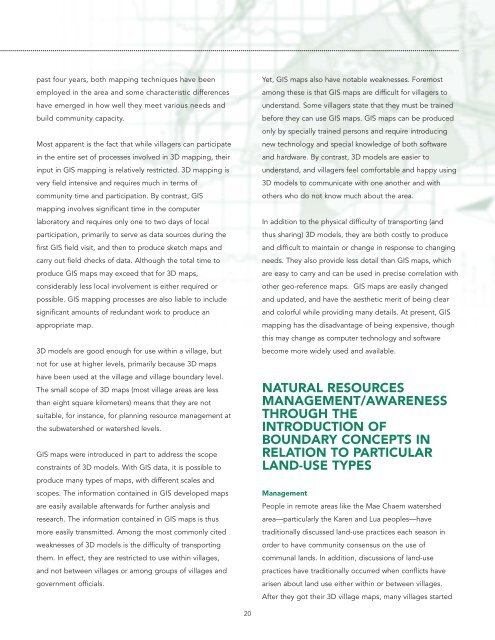FoxHershockMappingCommunities
FoxHershockMappingCommunities
FoxHershockMappingCommunities
You also want an ePaper? Increase the reach of your titles
YUMPU automatically turns print PDFs into web optimized ePapers that Google loves.
past four years, both mapping techniques have been<br />
employed in the area and some characteristic differences<br />
have emerged in how well they meet various needs and<br />
build community capacity.<br />
Most apparent is the fact that while villagers can participate<br />
in the entire set of processes involved in 3D mapping, their<br />
input in GIS mapping is relatively restricted. 3D mapping is<br />
very field intensive and requires much in terms of<br />
community time and participation. By contrast, GIS<br />
mapping involves significant time in the computer<br />
laboratory and requires only one to two days of local<br />
participation, primarily to serve as data sources during the<br />
first GIS field visit, and then to produce sketch maps and<br />
carry out field checks of data. Although the total time to<br />
produce GIS maps may exceed that for 3D maps,<br />
considerably less local involvement is either required or<br />
possible. GIS mapping processes are also liable to include<br />
significant amounts of redundant work to produce an<br />
appropriate map.<br />
3D models are good enough for use within a village, but<br />
not for use at higher levels, primarily because 3D maps<br />
have been used at the village and village boundary level.<br />
The small scope of 3D maps (most village areas are less<br />
than eight square kilometers) means that they are not<br />
suitable, for instance, for planning resource management at<br />
the subwatershed or watershed levels.<br />
GIS maps were introduced in part to address the scope<br />
constraints of 3D models. With GIS data, it is possible to<br />
produce many types of maps, with different scales and<br />
scopes. The information contained in GIS developed maps<br />
are easily available afterwards for further analysis and<br />
research. The information contained in GIS maps is thus<br />
more easily transmitted. Among the most commonly cited<br />
weaknesses of 3D models is the difficulty of transporting<br />
them. In effect, they are restricted to use within villages,<br />
and not between villages or among groups of villages and<br />
government officials.<br />
Yet, GIS maps also have notable weaknesses. Foremost<br />
among these is that GIS maps are difficult for villagers to<br />
understand. Some villagers state that they must be trained<br />
before they can use GIS maps. GIS maps can be produced<br />
only by specially trained persons and require introducing<br />
new technology and special knowledge of both software<br />
and hardware. By contrast, 3D models are easier to<br />
understand, and villagers feel comfortable and happy using<br />
3D models to communicate with one another and with<br />
others who do not know much about the area.<br />
In addition to the physical difficulty of transporting (and<br />
thus sharing) 3D models, they are both costly to produce<br />
and difficult to maintain or change in response to changing<br />
needs. They also provide less detail than GIS maps, which<br />
are easy to carry and can be used in precise correlation with<br />
other geo-reference maps. GIS maps are easily changed<br />
and updated, and have the aesthetic merit of being clear<br />
and colorful while providing many details. At present, GIS<br />
mapping has the disadvantage of being expensive, though<br />
this may change as computer technology and software<br />
become more widely used and available.<br />
NATURAL RESOURCES<br />
MANAGEMENT/AWARENESS<br />
THROUGH THE<br />
INTRODUCTION OF<br />
BOUNDARY CONCEPTS IN<br />
RELATION TO PARTICULAR<br />
LAND-USE TYPES<br />
Management<br />
People in remote areas like the Mae Chaem watershed<br />
area—particularly the Karen and Lua peoples—have<br />
traditionally discussed land-use practices each season in<br />
order to have community consensus on the use of<br />
communal lands. In addition, discussions of land-use<br />
practices have traditionally occurred when conflicts have<br />
arisen about land use either within or between villages.<br />
After they got their 3D village maps, many villages started<br />
20



